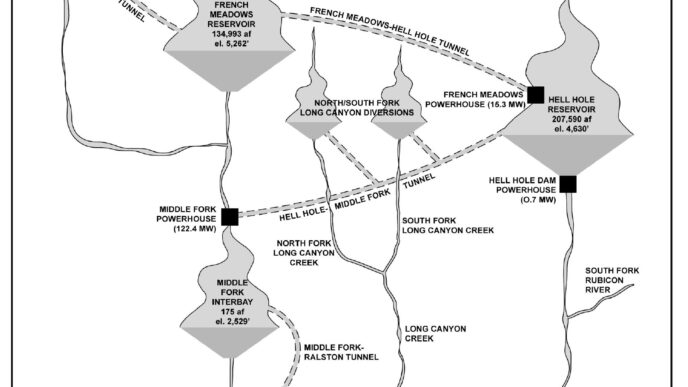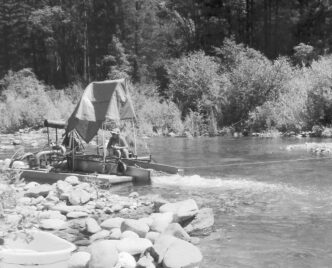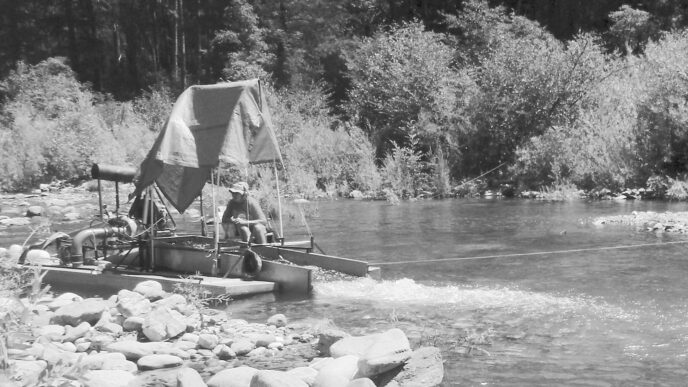In 2001, farmers in the upper Klamath Basin saw their irrigation water turned off in order to protect the Klamath River’s endangered salmon and longnose suckers. It was a decision that landed hard on an already depressed rural economy, and it ignited a firestorm of protest among the area’s irrigators. Then, in 2002, with Vice President Cheney working behind the scenes to deliver votes for conservative politicians, the irrigation gates were flung open over the protests of scientists. The result was the largest fish kill that the West Coast has ever seen.
Estimates of the dead salmon ranged as high as sixty thousand, pictures of the fish kill flooded the national news, and the Klamath was suddenly famous for all the wrong reasons. The effect on many groups — even those with diametrically opposing viewpoints over the Klamath’s water — was sobering.
By 2006, Klamath chinook salmon populations had not recovered from the 2002 fish kill, and commercial and sportfishing quotas saw dramatic cuts. In 2008 — with the Klamath salmon runs still weak and the Sacramento River salmon fishery collapsing — all commercial and sport fishing for salmon was closed on the Oregon and California coasts. This time, it was the commercial fishermen and sport-fishing businesses that suffered financial devastation.
Meanwhile, the Klamath’s coho salmon — listed as “threatened” under the Endangered Species Act — continued its downward spiral. Many biologists feel it’s only a matter of time before the coho joins the Klamath’s pink and chum salmon runs on the extinction list, with the spring chinook and summer steelhead runs headed there as well.
Another variable in these conflicts surfaced in 2006, when the Klamath River dams came up for relicensing, and the energy utility PacifiCorp, the company that owns them, was told they had to be retrofitted to meet current standards, including fish passage. The cost to retrofit? The relicensing authority, FERC, the Federal Energy Regulatory Commission, estimated that with fish passages, the dams would operate at a $20 million annual loss.
Eventually, irrigators, ranchers, conservation groups, commercial fishermen, and Native American tribes — all formerly at odds over the Klamath’s resources — realized that the Klamath River stalemate benefited only attorneys, so in an attempt to end the fighting, they entered into a series of negotiations.
The result was the Klamath Basin Restoration Agreement (KBRA) and its sister agreement, the Klamath Hydropower Settlement Agreement (KHSA). The KBRA and KHSA mandate the removal of the four PacifiCorp Klamath River dams and provide funding for salmon restoration. In 2010, the KBRA was signed by most — but not all — of the groups who negotiated it. Has peace finally come to the Klamath?
Anatomy of a Killer Dam
Once the third most productive salmon river on the West Coast, today’s Klamath River suffers from all the usual ills: too many water diversions, poor water quality, too much habitat lost to dams, too much dependence on hatchery fish, and too few salmon and steelhead returning to spawn. At the heart of the damage lies the four lower Klamath River dams: Iron Gate, Copco 1, Copco 2, and J. C. Boyle. The first was constructed in the early 1900s, the last in 1966.
These four PacifiCorp dams generate relatively little electricity. (If relicensed, they’d produce 61 megawatts annually, enough to power approximately forty-five thousand homes.) In addition to blocking access to four hundred–plus miles of steelhead and salmon spawning habitat, the Klamath River dams act as nutrient sinks; the Klamath River is naturally rich in phosphates, so the dams encourage summertime toxic algae blooms in their reservoirs. (Microcystis aeruginosa is the name of the algae; the lethal toxin they produce is called “microcystin.”) These toxic blooms contain cell counts four thousand times greater than what the World Health Organization considers a moderate health risk, and they turn the reservoirs a pea soup green. The toxic plume reaches all the way to the ocean. Most summers, visitors to the Klamath’s banks are greeted by posted health warnings about liver damage. Scientists now also associate microcystin poisoning with DNA damage.
The dams warm the Klamath’s water, stressing fish and rendering them more vulnerable to disease and parasites. Scientists were shocked when studies revealed the lethal Ceratomyxa shasta parasite infects as many as 60 percent of the outgoing juvenile chinook salmon. Not coincidentally, the greatest concentrations of it are found in the reach below Iron Gate Dam, the dam closest to the ocean.
In addition to the havoc they wreak on the Klamath, PacifiCorp’s hydropower dams have become an expensive liability; retrofitting them to meet current standards would cost $450 million. By contrast, the KHSA limits PacifiCorp’s dam removal liability to only $200 million. The actual cost is between $250 million and $297 million.
In simple terms, if the Klamath’s salmon are to survive, the dams will probably have to come out, and water quality issues will have to be addressed. Still, given the projected operating losses and the fact that PacifiCorp is not in the business of losing money, it seems likely that the dams will be felled by a spreadsheet as much as by environmental concerns.
Why Anglers Might Love the KBRA
Removing the four lower Klamath River dams and implementing the KBRA’s restoration programs would open 420 miles of spawning habitat to salmon and steelhead. Endangered coho salmon would likely take advantage of only the first 68 miles of that habitat, chinook more of it, and steelhead all of it. The draft Environmental Impact Report/Environmental Impact Statement says the KBRA should boost chinook salmon populations by 81 percent, a figure that has commercial fishermen, hammered by repeated fishing closures, excited.
California’s steelhead anglers might feel excited, as well, after reading this section of the Environmental Impact Report/Environmental Impact Statement:
Distribution of steelhead in the watershed is expected to expand to a greater degree than that of any other anadromous salmonid species under dam removal. Access to approximately 420 miles of historical habitat is estimated to again be available for steelhead upstream of the lowest dam.
Steelhead are the most prized game fish in the Klamath River; providing recreational fishing opportunities that would expand well into the Upper Basin in Oregon. Dam removal would also expand the total distribution of trophy Redband Rainbow trout in the fishery and would provide a more natural flow and temperature regime for trout and reintroduced salmon and steelhead.
In an interview, Northern California fly-fishing guide Craig Nielsen, who spends as much time fishing the Klamath’s relatively healthy winter steelhead runs as anybody, said, “If we can get the steelhead some cold water and habitat, it could become amazingly good. Think about it. Despite its problems, the Klamath remains one of the healthiest rivers in the state. The fly fishing is already good, and we’re still only seeing maybe 10 percent of the historic runs. It’s a good fishery that could become a really great fishery.”
The KBRA and KHSA: Solutions with Enemies
As with most all compromises, almost no one is entirely happy with the KBRA. Proponents say it offers a way forward — one that provides for irrigators and fish. Yet environmental critics say the KBRA doesn’t do enough to restore the salmon runs and that its $1 billion budget is stuffed with pork-barrel projects unrelated to the recovery of the fishery. Some Native American tribes say it unilaterally deprives them of tribal water rights. And on the far end of the spectrum, the KBRA has become a whipping boy for property-rights extremists and anti-environmental activists who have alleged that the KBRA is built atop a foundation of “junk” science and that removing the dams will actually decimate the salmon, which they claim benefit from the dams instead of being harmed by them.
In meetings and on videos, dam removal opponents have suggested that the KBRA is part of a heavy-handed governmental war on rural communities, and in several cases, I’ve seen assertions the KBRA is part of a plot to drive farmers and ranchers from their land so the UN can create a wildlife preserve. Another “expert” suggests that the government’s goal is to move irrigators off of cheap hydro generated electricity and make them dependent on higher-priced power from fossil fuels — a clear attempt to bankrupt ranchers and reclaim the land.
It gets worse. A commonly repeated “fact” among dam-removal opponents is that the protected coho salmon are not native to the Klamath watershed and that the Klamath population is the result of an 1895 stocking in the Trinity River, a tributary of the Klamath. A petition to delist the coho as a threatened species was even submitted by the Siskiyou County Water User’s Association.
A cursory examination of the petition reveals a rambling, disjointed document that relies heavily on a quote from a 1913 California Fish and Game report. A few minutes of research revealed the following: the quote was truncated to change its meaning, altered to change its context (two words were added), and misattributed. (It’s from an 1895 document, not a 1913 document.)
Even the Siskiyou County Board of Supervisors is adamantly opposed to dam removal, though their list of reasons why seems to be steadily shrinking. Supervisors Michael Kobseff, Jim Cook, and Marcia Armstrong have repeatedly cited the loss of irrigation water and property tax revenues and fears about toxic sediments and flooding, yet all these issues have already been answered. The dams provide no irrigation water, the states will replace lost tax revenues, the sediments have been tested, and the dams provide almost no flood control capability.
In truth, the opposition to dam removal represents a pronounced antigovernment bias in Siskiyou County, whose supervisors and sheriff publicly blame government regulation (especially the coho salmon’s Endangered Species Act listing) for all the county’s woes, including its high rates of domestic violence and unemployment.
In that context, you’d think they would embrace the KBRA; the draft Environmental Impact Report/Environmental Impact Statement says that dam removal would create forty-six hundred jobs over the 15-year life of the KBRA, create “water security” (and jobs) for irrigators, and grow a healthy, sustainable recreation economy.
In a recent newspaper interview, California Trout’s conservation director Curtis Knight said, “We continue to be disappointed that the supervisors are not seeing the opportunity [the KBRA] will bring to Siskiyou. From my standpoint, it would be beneficial to be involved in solving problems. That would ensure a much better outcome for Siskiyou County.”
What’s Next for the Klamath
The KBRA and KHSA can’t be enacted until Congress passes legislation, and that legislation, introduced in the U.S. Senate by Oregon Senator Jeff Merkley and in the House by California Congressman Mike Thompson, has stalled in a gridlocked Congress. For now, KBRA and KHSA supporters are moving forward; dam removal wasn’t supposed to begin until 2020, so KBRA supporters will reintroduce legislation next year.
Still, the question remains: What if the KBRA/KHSA process fails? More likely than not, the FERC dam relicensing process would be restarted, and the economics of the situation suggest dam removal is still the most likely result, though without the water agreements and restoration money promised by the KBRA. Relicensing the dams would cost PacifiCorp almost twice as much as removing them. And as I’ve noted, once retrofitted, they’d operate at a $20 million annual loss, so unless PacifiCorp is allowed to maintain the dams as they are now and get the water quality approvals that most believe they can’t get as long as the dams remain in place, the Klamath River dams will likely fall victim to capitalism, not to some tyrannical government agency bent on destroying rural life.
California’s anglers, especially those familiar with the Klamath’s excellent winter steelhead run and potential as a world class steelhead fishery, will be watching closely. Should the four lower Klamath River dams start to come down in 2020, California could see one of its best steelhead and salmon fisheries come to life, albeit not at historic levels. If the Klamath River dams remain in place, it’s likely that many of the Klamath’s salmon and steelhead runs will continue their downward spirals toward extinction.
Editor’s note: Tom Chandler lives in the Siskiyou County town of Mt. Shasta, from where he runs the highly-regarded fly-fishing blog, http://troutunderground.com, and occasionally heads up I-5 to fish the Klamath.
If You Want More Information . . .
For studies and documents relating to the Klamath Basin Restoration Agreement (KBRA) and the Klamath Hydropower Settlement Agreement (KHSA), consult the Department of the Interior’s Klamath Water Basin Issues website, http://klamathrestoration.gov. You can also consult California Trout’s arguments on these issues, The Case For Klamath River Dam Removal, at the Web site http://bit.ly/H9GQes.
Tom Chandler













